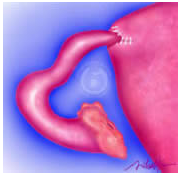Essure Reversal And Adiana Reversal
Essure and Adiana hysteroscopic tubal sterilizations can be reversed.
Essure and Adiana are two new methods blocking the fallopian tubes that have been recently introduced in the US. These tubal ligation techniques can be performed in the doctor’s office using a hysteroscope. They avoid having a surgical incision and do not require general anesthesia. Because of these factors and their lower cost than laparoscopy or laparotomy, Essure and Adiana are becoming increasingly popular. As with other methods of tubal ligation, some women will have a change of mind and subsequently want to become pregnant again. Requests for Essure reversal and Adiana reversal are expected to increase in the future.
Essure Reversal
Essure reversal is possible through tubouterine implantation. This tubal reversal technique is performed through a small abdominal incision.

The uterine cavity is exposed by making an incision in the uterine muscle. The healthy portion of each tube is inserted into the uterine cavity on both sides of the uterus, or through a single incision in the back of the uterus. Tubal implantation bypasses the scarred portion of the tube and reverses the tubal blockage caused by the Essure procedure.
Adiana Reversal
The tubal reversal doctors at Chapel Hill Tubal Reversal Center performed the first successful reversal of Adiana tubal sterilization. Dr. Berger and Dr. Monteith performed bilateral tubal implantation for Lisa D. who underwent sterilization by the Adiana technique as part of an experimental trial to test the new sterilization procedure six years previously. Although this operative technique had not previously been used specifically for Adiana reversal, it has been successful in treating tubal blockage in the area of the tubes where the Adiana procedure had caused scarring of the fallopian tubes.
During a one hour and ten minute tubal surgery procedure. The healthy fallopian tubes were separated from the blockage and tubal implantation was performed through a newly created opening in the back of the uterus. Since the Adiana sterilization involves a small segment of the narrowest part of the fallopian tube, long tubal segments remain after the reversal procedure which is a major factor in tubal reversal success rates. On October 9th, 2009 the patient, Tina D., reported a positive pregnancy test that confirmed the success of the first Adiana reversal procedure.
Tubal reversal procedures
There are 3 basic methods of tubal sterilization reversal:
- Tubal Anastomosis – rejoins two segments of the fallopian tube
- Tubal Implantation – bypasses tubal blockage within the uterine wall
- Salpingostomy – opens the end of the tube near the ovary
